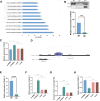RBM10 regulates alternative splicing of lncRNA Neat1 to inhibit the invasion and metastasis of NSCLC
- PMID: 36335386
- PMCID: PMC9636673
- DOI: 10.1186/s12935-022-02758-w
RBM10 regulates alternative splicing of lncRNA Neat1 to inhibit the invasion and metastasis of NSCLC
Abstract
Background: Non-small cell lung cancer (NSCLC) accounts for more than 85% of the total cases with lung cancer. NSCLC is characterized by easy metastasis, which often spreads to bones, brains and livers. RNA-binding motif protein 10 (RBM10) is an alternative splicing (AS) regulator frequently mutated in NSCLC. We found that there were multiple peak binding sites between RBM10 and long non-coding RNA nuclear enriched abundant transcript 1 (LncRNA Neat1) by crosslinking-immunprecipitation and high-throughput sequencing (Clip-Seq). LncRNA Neat1 plays an indispensable role in promoting cancer in a variety of tumors and produces two splicing variants: Neat1_1 and Neat1_2. This study aims to explore the mechanism of RBM10 and LncRNA Neat1 in invasion and metastasis of NSCLC.
Methods: Through histological and cytological experiments, we assessed the expression level of RBM10 protein expression. The interaction between RBM10 and Neat1 was evaluated via Clip-Seq and RNA immunoprecipitation assay. The effect of RBM10 on Neat1 and its splicing variants was identified by RT-qPCR. The effect of RBM10 and Neat1 on invasive and metastasis phenotypes of NSCLC was analyzed using transwell invasion assay and scratch test. Additionally, downstream signaling pathway of RBM10 were identified by immunofluorescence and western blot.
Results: RBM10 exhibited low levels of expression in NSCLC tissues and cells. RBM10 inhibited the invasion and metastasis of NSCLC and recruited Neat1 and Neat1_2. Overexpression of RBM10 simultaneously inhibited Neat1 and Neat1_2, and promoted the expression of Neat1_1. On the other hand, silencing RBM10 promoted Neat1 and Neat1_2, and inhibited the expression of Neat1_1. From this, we concluded that RBM10 regulated AS of Neat1, and the tumor-promoting effect of Neat1 was mainly attributed to Neat1_2. RBM10 had a negative correlation with Neat1_2. In addition, RBM10 upregulated the expression of PTEN and downregulated the phosphorylation of PI3K/AKT/mTOR through Neat1_2, which ultimately inhibited the invasion and metastasis of NSCLC.
Conclusion: The RBM10 regulated AS of Neat1 to cause the imbalance of Neat1_1 and Neat1_2, and RBM10 suppressed the activation of the PTEN/PI3K/AKT/mTOR signal by downregulating Neat1_2, finally affected the invasion and metastasis of NSCLC.
Keywords: Alternative splicing; Invasion; Metastasis; NSCLC; RBM10; lncRNA Neat1.
© 2022. The Author(s).
Conflict of interest statement
The authors declare no competing interests.
Figures








References
-
- Siegel RL, Miller KD, Fuchs HE, Jemal A. Cancer statistics, 2022. CA Cancer J Clin. 2022;72:7–33. - PubMed
Grants and funding
LinkOut - more resources
Full Text Sources
Research Materials
Miscellaneous

